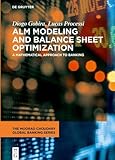ALM Modeling and Balance Sheet Optimization : A Mathematical Approach to Banking / Diogo Gobira, Lucas Duarte Processi.
Material type: TextSeries: The Moorad Choudhry Global Banking SeriesPublisher: Berlin ; Boston : De Gruyter, [2023]Copyright date: ©2023Description: 1 online resource (XII, 204 p.)Content type:
TextSeries: The Moorad Choudhry Global Banking SeriesPublisher: Berlin ; Boston : De Gruyter, [2023]Copyright date: ©2023Description: 1 online resource (XII, 204 p.)Content type: - 9783110664225
- 9783110664386
- 9783110664669
- 330
- online - DeGruyter
- Issued also in print.
| Item type | Current library | Call number | URL | Status | Notes | Barcode | |
|---|---|---|---|---|---|---|---|
 eBook
eBook
|
Biblioteca "Angelicum" Pont. Univ. S.Tommaso d'Aquino Nuvola online | online - DeGruyter (Browse shelf(Opens below)) | Online access | Not for loan (Accesso limitato) | Accesso per gli utenti autorizzati / Access for authorized users | (dgr)9783110664669 |
Frontmatter -- Foreword -- Preface -- Contents -- 1 Introduction -- 2 Modeling Guidelines -- 3 Fundamental Concepts: Balance Sheet Model -- 4 Fundamental Concepts: Mathematical Programming -- 5 Data Preparation Pipeline -- 6 Building the Model: Foundations -- 7 Building the Model: Business Rules -- 8 Running the Model -- 9 Adding Uncertainty -- 10 Troubleshooting Strategies -- 11 Conclusions -- Appendix A Introduction to Julia, JuMP, and SDDP -- Bibliography -- List of Figures -- List of Tables -- List of Code Snippets -- About the Authors -- About the Series Editor -- Index
restricted access online access with authorization star
http://purl.org/coar/access_right/c_16ec
ALM Modeling and Balance Sheet Optimization is a comprehensive book that combines theoretical exploration with practical guidance and code examples on implementing a balance sheet optimization model. The book emphasizes the use of stochastic dynamic programming to develop a deep and holistic understanding of the banking problem. Encompassing the entire implementation stack – spanning from data layers to the specification of decision variables, business and regulatory constraints, objective functions, modeling strategies, solving techniques, debugging, and reporting – this book serves as a comprehensive guide for constructing highly effective balance optimization models from scratch, enabling the maximization of banking outcomes. Readers will learn how to build a mathematical model capable of generating projections for portfolios; balance sheet, income and cash flow statements; capital, and risk measures in real-world scenarios. This practical approach is particularly valuable for professionals involved in integrated stress testing, capital adequacy assessment, financial planning, and optimization tasks. In essence, the book offers valuable insights into the challenges of balance sheet optimization, providing readers with the necessary tools to build their own dynamic and comprehensive ALM models.
Issued also in print.
Mode of access: Internet via World Wide Web.
In English.
Description based on online resource; title from PDF title page (publisher's Web site, viewed 26. Apr 2024)


